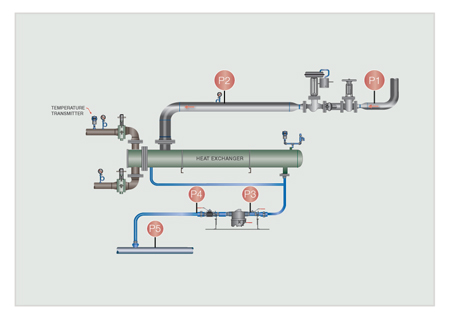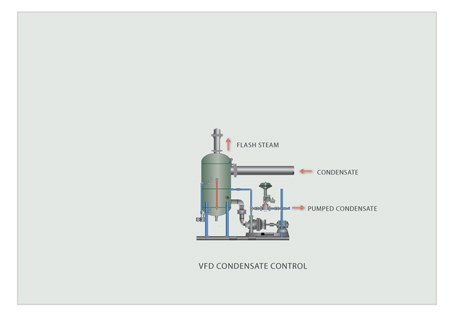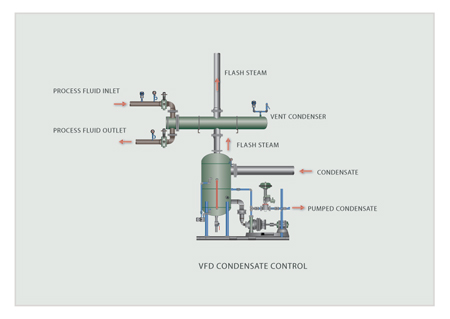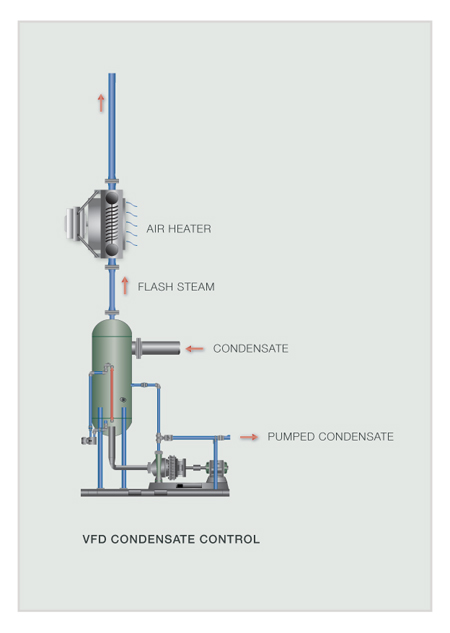With today’s energy prices and the need to reduce emissions, a plant cannot allow its steam/condensate systems to vent flash steam to the atmosphere.
Depending on the installation costs, plants will typically recover the cost of a flash steam vent condenser within 10 operational months. The cost-saving benefits of a flash steam vent condenser include allowing a plant to recover the flash steam energy and use that energy to heat a fluid for a process. It also reduces emissions since the boilers will have to produce less steam if the flash steam energy is recovered.
Flash Steam Recovery Systems (Modulating Steam Conditions)
If the condensate/flash steam (two-phase flow) is discharged from a modulating steam/condensate process, the process application has a steam control valve modulating the steam to the process, and the control valve can operate from zero (closed) to 100 percent (full open) and anywhere in between (see Figure 1). The steam pressure after the steam control and before the process heat exchanger can vary (P2 reading) depending on the process conditions. The pressure at P2 can range from full line pressure that is delivered to the steam control valve (P1) all the way down to zero pressure.
In this case, the flash steam cannot be recovered in a pressurized flash tank or high-pressure condensate return system. Instead, the condensate flow from the process has to be discharged into a condensate line pressure (P5) at 0 psig and delivered to a vented condensate receiver tank operating at or close to zero pressure.

Figure 1. Steam control valve
Figure 2 depicts the typical condensate receiver tank arrangement, where the flash steam is allowed to vent to the atmosphere. The energy loss and emission factors today do permit this loss in the system.

Figure 2. Typical condensate receiver tank
A flash steam vent condenser is incorporated in the system to recover the flash steam by using an external heat exchanger (condenser) as seen in Figure 3. The vent condenser (heat exchanger) will consume the flash steam by heating air, water or some other process fluids. The vent condenser is designed for the application to ensure proper operation. A standard shell and tube heat exchanger functions in this application. The process fluid consumes the flash steam and allows the condensate to drain back into the condensate tank. Therefore, the flash steam is consumed and the condensate is recovered. In the case of a modulating steam process condition, the process steam system should use the lowest steam pressure, therefore producing the least amount of flash steam.

Figure 3. External heat exchanger (condenser)
Condenser
The shell and tube heat exchanger designed for a condenser application is the typical heat transfer design used in flash steam condensers. Other heat exchanger units that can be used are spiral, plate and frame, and fin coil units (heating units for air or process gases). Materials and installation considerations will vary depending on the application. All vented condensers are engineered for the application.
Fluid for the Condenser
To condense the flash steam, the condenser requires a fluid temperature of less than 160 deg F (general consideration). The fluid can be a liquid or vapor, depending on the application. If an insufficient quantity of cooling fluid for the flash steam is in a liquid cooling system, then the plant should consider using a flash steam bypass or some other method to prevent the cooling liquid from absorbing too much energy and changing from a liquid to a vapor, causing water hammer.
Heating air is another application for a vent condenser. Figure 4 shows the air passed over a tube fin configuration with the flash steam inside the tube. The lower temperature air condenses the flash steam and the condensate is allowed to drain back into the condensate tank.

Figure 4. Heating air using a vent condenser
Pressure on the Condensate Tank
In choosing the design of the vent condenser, the plant must ensure it chooses a design that does not create significant pressure for the condensate receiver tank. The flash steam vent line from the condensate tank to the condensing unit velocities should not exceed 900 feet per minute.
Required Information
To purchase, install and operate a vent condenser successfully, the plant should know whether the following parameters are maximum, minimum or normal:
1. Condensate flow rate
2. Flash steam flow rate
3. Cooling fluid flow rate
Checklist
1. Find and document the different flash steam vent lines discharging to the atmosphere.
2. Determine the flash steam loss to the atmosphere.
3. Calculate the projected energy loss and emissions reduction.
4. Determine what types of cooling fluids are available.
5. Install a condensate tank with a vent condenser.
Next month we will look at flash steam recovery from non-modulating steam applications.
Pumps & Systems, June 2010

